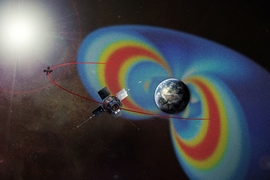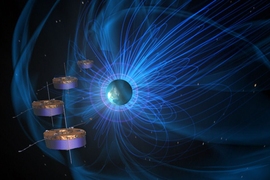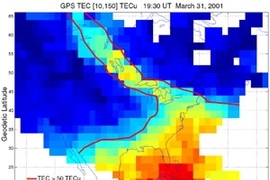John C. Foster, principal research scientist at MIT's Haystack Observatory, has been awarded AGU Fellow status from the American Geophysical Union for 2017. The AGU elects a small group of members to become fellows each year in honor of their scientific leadership and research excellence. Recipients are AGU members who have fundamentally advanced research in their fields of geophysics.
"AGU Fellows are recognized for their scientific eminence in the Earth and space sciences. Their breadth of interests and the scope of their contributions are remarkable and often groundbreaking," the announcement read. "They have expanded our understanding of the Earth and space sciences, from volcanic processes, solar cycles, and deep-sea microbiology to the variability of our climate and so much more. Only 0.1 percent of AGU membership receives this recognition in any given year."
A group of space science colleagues nominated Foster for this award, citing his visionary leadership in space physics research, including transformative insights and work in magnetosphere-plasmasphere-ionosphere coupling, ionospheric storm response, and radiation belt dynamics. A large portion of Foster’s research has been done with ground and space-based observational techniques, including incoherent scatter radar and satellite-borne instruments, using these powerful tools for investigations of the physics of the upper atmosphere and Earth's highly energetic radiation belts. He is an expert in the analysis of data from ionospheric radars at Haystack's Millstone Hill and other facilities. Foster also has been extensively involved in international scientific collaboration with colleagues in China, Ukraine, and Russia.
"John’s excellence and sharp observational eye continues to lead the field in applications of multiple observational points of view from both ground and space remote sensors, creating new insights on the workings of the complicated Sun-Earth system and its dynamics," says Phil Erickson, assistant director at Haystack Observatory. "He is truly outstanding at seeing connections in phenomena that have previously been studied only in isolation."
Broad interests in space science continue today to lead Foster towards innovative and far reaching insights within the vitally important study of cross-scale and cross-disciplinary coupling processes in Earth’s near-space environment. He is an innovator in the application of high-power ionospheric radar systems to the study of plasmas and instabilities in the terrestrial mid-latitude ionosphere.
Foster’s work has taken place across multiple institutions in a career that has lasted more than four decades. After receiving his PhD in physics from the University of Maryland at College Park in 1973, he worked at a number of institutions, including the National Research Council of Canada and Utah State University. In 1983, former Haystack director John Evans recruited Foster to lead its internationally known atmospheric science program. He led this group for more than 30 years, maintaining and significantly growing the scientific and technical staff throughout this time period. He was appointed assistant director of Haystack in 1983 and promoted to principal research scientist in 1988, achieving associate Haystack director status in 1995. Throughout his career, Foster has dedicated much time and effort to mentoring a large number of younger space scientists.
Even beyond this large body of prior work, Foster continues his extensive publication record and a brisk collaboratory pace of fundamental and unique discoveries in space science. His most recent work using data from the twin NASA Van Allen Probes spacecraft was published earlier this year in the AGU's Journal of Geophysical Research Space Physics. The study provides an example of Foster’s innovative observational approach, as he and several colleagues analyzed the nonlinear interactions of ultrarelativistic electrons and very low frequency waves to advance understanding of rapid variations in Earth's outer radiation belt.










